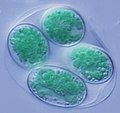
Back Аҵиаақәа Abkhazian Peunula ACE Plant Afrikaans Pflanzen GSW አትክልት Amharic Plantae AN Plante ANG पौधा ANP نبات Arabic عشبة ARY
| Plants Temporal range:
| |
|---|---|
| Scientific classification | |
| Domain: | Eukaryota |
| Clade: | Diaphoretickes |
| Clade: | CAM |
| Clade: | Archaeplastida |
| Kingdom: | Plantae H. F. Copel., 1956 |
| Superdivisions | |
|
See text | |
| Synonyms | |
| |
Plants are the eukaryotes that comprise the kingdom Plantae; they are predominantly photosynthetic. This means that they obtain their energy from sunlight, using chloroplasts derived from endosymbiosis with cyanobacteria to produce sugars from carbon dioxide and water, using the green pigment chlorophyll. Exceptions are parasitic plants that have lost the genes for chlorophyll and photosynthesis, and obtain their energy from other plants or fungi. Most plants are multicellular, except for some green algae.
Historically, as in Aristotle's biology, the plant kingdom encompassed all living things that were not animals, and included algae and fungi. Definitions have narrowed since then; current definitions exclude fungi and some of the algae. By the definition used in this article, plants form the clade Viridiplantae (green plants), which consists of the green algae and the embryophytes or land plants (hornworts, liverworts, mosses, lycophytes, ferns, conifers and other gymnosperms, and flowering plants). A definition based on genomes includes the Viridiplantae, along with the red algae and the glaucophytes, in the clade Archaeplastida.
There are about 380,000 known species of plants, of which the majority, some 260,000, produce seeds. They range in size from single cells to the tallest trees. Green plants provide a substantial proportion of the world's molecular oxygen; the sugars they create supply the energy for most of Earth's ecosystems, and other organisms, including animals, either eat plants directly or rely on organisms which do so.
Grain, fruit, and vegetables are basic human foods and have been domesticated for millennia. People use plants for many purposes, such as building materials, ornaments, writing materials, and, in great variety, for medicines. The scientific study of plants is known as botany, a branch of biology.
- ^ Cavalier-Smith, Tom (1981). "Eukaryote kingdoms: Seven or nine?". BioSystems. 14 (3–4): 461–481. Bibcode:1981BiSys..14..461C. doi:10.1016/0303-2647(81)90050-2. PMID 7337818.
- ^ Lewis, L.A.; McCourt, R.M. (2004). "Green algae and the origin of land plants". American Journal of Botany. 91 (10): 1535–1556. Bibcode:2004AmJB...91.1535L. doi:10.3732/ajb.91.10.1535. PMID 21652308.
- ^ Kenrick, Paul; Crane, Peter R. (1997). The origin and early diversification of land plants: A cladistic study. Washington, D.C.: Smithsonian Institution Press. ISBN 978-1-56098-730-7.
- ^ Adl, S. M.; et al. (2005). "The new higher level classification of eukaryotes with emphasis on the taxonomy of protists". Journal of Eukaryotic Microbiology. 52 (5): 399–451. doi:10.1111/j.1550-7408.2005.00053.x. PMID 16248873. S2CID 8060916.







